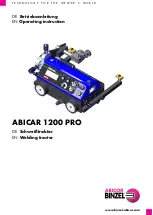
FUNCTIONS
GB
(GB) 3
GB
5.4
CONNECTION AND PREPARATION OF EQUIPMENT FOR GTAW (TIG LIFT)
WELDING .
• SWITCH THE WELDING MACHINE OFF BEFORE CARRYING OUT THE CONNEC-
TIONS.
Connect the welding accessories carefully in order to avoid power losses or
dangerous gas leaks. Carefully comply with the safety rules.
1.
Select TIG LIFT welding mode
(Section 9 ).
2.
Fit the required electrode and gas-guide nozzle on the electrode holder
torch. (Check the condition of electrode tip and protrusion).
3.
Connect the earthing lead connector to the quick-release positive terminal
(+) and the clamp near the welding zone.
4.
Connect the torch power cable connector to the quick-release negative ter-
minal (-) .
5.
Connect the gas pipe to the regulator on the gas bottle.
6.
Adjust the welding current to the required value
(Section 12).
Adjust the welding parameters (upslope and downslope) to the required val-
ues.
7.
Open the gas cock.
8.
Remote control connection.
To use the remote control, connect the remote control connector to the
socket on the front panel. In this condition the current can be adjusted
independently of the setting made on the generator.
9.
Switch the generator on.
6.0 FUNCTIONS
6.1
FRONT PANEL
Figure 1.
1 - REMOTE CONNECTOR (Rif.1
- Fig. 1 page 3) : the remote control can be con-
nected by means of this connector. With this accessory the welding current can
be varied with continuity without leaving the work zone. Remote control connec-
tion is signalled on the display for a few seconds
(Rif.4
- Fig. 1 page 3) by the
message ”rEn”.
2 - CURRENT OUTPUT INDICATOR
(Green)
(Rif.2
- Fig. 1 page 3) : this indicator
lights up in the presence of welding current.
3 - ALARM INDICATOR
(Yellow)
(Rif.3
- Fig. 1 page 3) : this indicator lights up
when the generator does not work due to an alarm. Given below are the possible
alarms signalled on the display, their meaning and operations to be carried out to
restore generator operation.
4 - DIGITAL DISPLAY (Rif.4
- Fig. 1 page 3) : indicates the set welding current, in
particular:
- During welding it indicates the generator output current.
- In the welding parameter modification phase it indicates the actual value of the
quantity selected.
- In alarm conditions it identifies the type of alarm activated.
5 - HOT START/ARC FORCE RATE INDICATOR (Rif.5
- Fig. 1 page 3) : this indi-
cator lights up when the HOT START or ARC FORCE percentage value set for the
MMA welding process is being displayed.
6 - UP/DOWNSLOPE TIME INDICATOR (Rif.6
- Fig. 1 page 3) : this indicator
lights up when the up/down time (in seconds) of the current slopes associated
with the LIFT TIG welding process is being displayed.
7 - WELDING CURRENT INDICATOR (Rif.7
- Fig. 1 page 3) : this indicator lights
up when the set current value (in amperes) or read value (in the case of welding in
progress) is being displayed.
8 -
MMA COATED ELECTRODE WELDING INDICATOR (Rif.8
- Fig. 1
page 3) : normal basic and rutile coated electrodes can be welded in this mode.
9 -
TIG WELDING WITH LIFT START INDICATOR (Rif.9
- Fig. 1 page 3) :
this TIG welding mode is carried out with the following procedure:
ARC STRIKING:
touch the workpiece with the electrode to cause
short-circuiting between the workpiece (2) and elec-
trode (1) then lift it to strike the arc. The integrity of
the electrode tip is guaranteed by a low striking cur-
rent during the short circuit between workpiece and
electrode. Striking is always perfect even at mini-
mum welding current setting and enables work to be
performed without polluting the surrounding envi-
ronment with the very strong electromagnetic inter-
ference typically caused by high frequency
discharge.
The advantages can be summarized as follows:
a.
Start without requiring high frequency.
Start without ruining the electrode tip at any current
setting, therefore there is no inclusion of tungsten inside the workpiece (a phe-
nomenon that occurs with stroke start).
ARC EXTINGUISHING:
To exit the welding phase the operator can use the conven-
tional lift method or, alternatively, a new method that simulates the torch button.
8 9
10
11 12
1 2 3 4
5 6 7
SIGNALLING
ON THE DISPLAY
(Meaning)
CAUSES - CURE
- - -
(Line alarm)
CA.wer supply voltage, main switch off or no
phase.
CU.Restore the correct generator power supply.
CA.Fault in supply/control stage.
CU.Contact Technical Assistance.
thA
(Thermal alarm)
CA.Power converter overtemperature due to
excessive work cycle.
CU.Stop welding and leave the generator on until
the alarm ceases.
ScA
(Short circuit alarm)
CA.Generator output terminals short-circuited.
CU.Eliminate the short circuit.
CA.Fault in output stage.
CU.Contact Technical Assistance.
PiF
(Inverter alarm)
CA.Inverter stage fault.
CU.Contact Technical Assistance.
FXX
(Hardware anomaly)
CA.Malfunction in generator control stage (“XX”
is a number identifying the type of fault).
CU.Contact Technical Assistance.
EEE
(Software anomaly)
CU.Contact Technical Assistance.





































